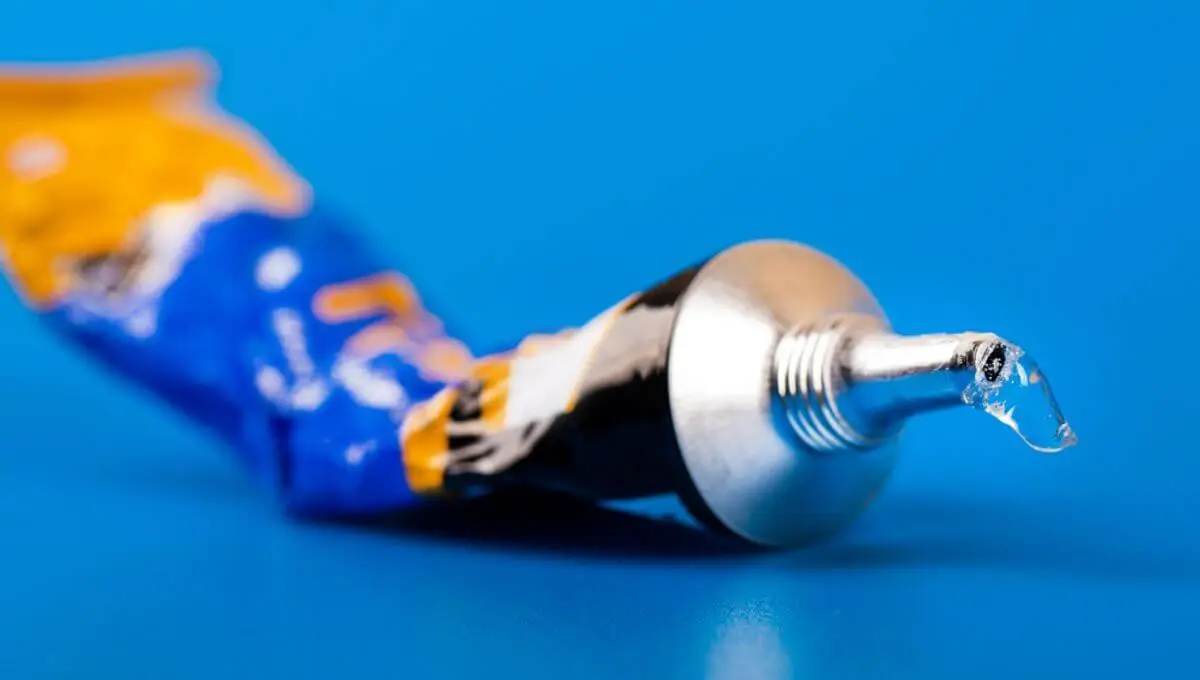Glue tasting—yes, you heard it right. While the thought might raise a few eyebrows or trigger a few chuckles, the question remains: what does glue taste like? It’s one of those odd queries that might pop into our minds, fueled by curiosity or perhaps a moment of sheer randomness.
Let’s dive into this peculiar topic and uncover the taste, health risks, and even unique uses of glue beyond its intended purpose.
The Taste of Glue
First things first, what exactly does glue taste like? Well, if you’ve ever accidentally gotten a tiny dab of glue on your fingers and, by chance, tasted it. You probably remember the distinctively bitter and unpleasant flavor.
Most glues contain chemicals such as polymers, resins, solvents, and additives that are certainly not meant for consumption. These ingredients contribute to the unpalatable taste that can linger unpleasantly in your mouth.
Tasting glue isn’t just an unusual experiment; it can also be dangerous. Many glues contain toxic substances that can cause harm if ingested, even in small amounts. While a tiny taste might not immediately send you to the emergency room, repeated exposure or ingestion of glue can lead to serious health issues.
What is Glue?
Glue is a sticky substance use to bond different materials together. Its history dates back centuries, with ancient civilizations using tree sap as their earliest adhesive. Modern technology has given rise to synthetic adhesives like cyanoacrylate and epoxies.
Glues can be derive from various sources, including animal products (gelatin), plants (starch), or petroleum-based chemicals (polyvinyl acetate), each with unique properties.
Health Risks of Glue Ingestion
Ingesting glue, even in small quantities, poses several health risks. The chemicals found in glue can irritate the mouth, throat, and digestive tract. Symptoms of glue ingestion may include nausea, vomiting, abdominal pain, and diarrhea. In more severe cases, ingesting certain types of glue can lead to chemical burns, respiratory problems, and neurological issues.
Children are particularly vulnerable to the dangers of ingesting glue, as they may be attract to its colorful packaging or tempted by its enticing scent. Parents and caregivers should take precautions to keep glue and other potentially harmful substances out of reach of young children and educate them about the dangers of ingesting non-food items.
Recognizing Glue Poisoning Symptoms
Symptoms can include difficulty breathing, chest pain, stomach discomfort or cramps, and decreased coordination.
The Sweetness of Adhesives
While not intended for consumption, adhesives like glue do have a subtle sweetness due to the sugar-based compounds present in most formulations. Some variations may carry distinct flavors based on their composition, potentially triggering allergic reactions in sensitive individuals.
Varieties of Glue
There’s a wide array of glues available, each with different chemical compositions, appearances, textures, and aromas. Whether you’re using a liquid, paste, or stick variety, these characteristics can vary greatly.
- White glue: This type of glue is made from polyvinyl acetate (PVA) and has a slightly sweet taste with a hint of bitterness.
- Elmer’s glue: This brand of white glue is know for its strong, sweet taste.
- Super glue: This type of glue is made from cyanoacrylate and has a very bitter taste.
- Wood glue: This type of glue is made from a variety of chemicals, including formaldehyde, and has a very unpleasant taste.
- Epoxy glue: This type of glue is made from epoxy resin and hardener, and has a very chemical taste.
Proper Storage and Preservation
To extend the shelf life and effectiveness of conventional adhesives, it’s essential to store them correctly. Seal liquid glues tightly after each use, and protect them from excessive heat, high humidity, and temperature fluctuations.
Different Glues and Their Tastes
Elmer’s Glue
Elmer’s glue is a household name knowing for its versatility and effectiveness in bonding paper, wood, fabric, and more. But what does it taste like? We’ll uncover the flavors and explore some surprising culinary comparisons that might intrigue you.
Flavor Profile and Characteristics: Elmer’s glue surprises with its mild and almost sweet taste. It leaves a slightly starchy sensation on the tongue, reminiscent of rice flour.
Gorilla Glue: The Strong and Versatile Choice
Gorilla Glue lives up to its name with its exceptional strength and wide range of applications.
Flavor Profile and Characteristics: Gorilla Glue offers a more robust and earthy taste with hints of pine and resin. Its intensity sets it apart from other glues.
Popular Culinary Comparisons: Some bold tasters liken the flavor of Gorilla Glue to pine nuts, adding a touch of adventure to their culinary repertoire.
Braces Glue: Holding Smiles Together
For those who have undergone orthodontic treatment, braces glue holds a special place in their memories.
Flavor Profile and Characteristics: Braces glue surprises with its milder taste compared to other glues.
Popular Culinary Comparisons: Some individuals relate the taste of braces glue to the sweetness of honey, bringing a touch of nostalgia to their taste buds.
Gorilla Glue Strain: Beyond Adhesives
Hold on, we’re not talking about the adhesive this time. The Gorilla Glue strain is a popular cannabis variety know for its potency and unique flavors.
Flavor Profile and Characteristics: As we shift from adhesives to cannabis, the Gorilla Glue strain impresses with its complex flavor palette. It combines notes of pine, chocolate, and even a hint of coffee.
Popular Culinary Comparisons: Tasters often draw parallels between the Gorilla Glue strain and gourmet chocolate, making it a delightful exploration for cannabis enthusiasts.
Glitter Glue: Adding Sparkle to Artwork
Glitter glue brings a touch of magic to children’s artwork and craft projects. But what does it taste like?
Flavor Profile and Characteristics: Glitter glue surprises with its subtle sweetness, reminiscent of sugar cookies with a touch of sparkle.
Popular Culinary Comparisons: As an adhesive with added glimmer, some tasters associate the taste of glitter glue with sugary confections like cotton candy
Glue Stick: The Mess-Free Option
The trusty glue stick is a favorite among students and professionals for its mess-free application. Let’s find out if its taste matches its convenient design and explore any culinary connections.
Flavor Profile and Characteristics: Glue sticks have a mild and almost tasteless nature, focusing on functionality rather than flavor.
Popular Culinary Comparisons: With its neutral taste, glue sticks don’t offer any culinary comparisons. It is a staple tool for everyday tasks and crafting projects.
Is Glue Tasting Safe? Potential Risks
Before attempting any glue tasting, it’s essential to understand the potential risks involved. We’ll discuss the safety aspects and guide responsible exploration.
Identifying Non-Toxic Glues for Tasting
Not all glues are safe for consumption. In this section, we’ll list non-toxic glues suitable for tasting, ensuring your adventure remains harmless and enjoyable.
Tips for Responsible Glue Tasting
Engaging in glue tasting should be done with caution and responsibility. We’ll share some tips to ensure you have a safe and enjoyable experience without any adverse effects.
The Glue Tasting Experience
Now that we’ve laid the groundwork, it’s time to explore the glue-tasting experience itself:
Setting Up for Glue Tasting: Dos and Don’ts
Preparation is key to a successful glue-tasting session. We’ll outline the dos and don’ts to make your experience enjoyable and mess-free.
Using Different Types of Glues for Tasting
To fully appreciate the diversity of glue flavors, we’ll guide you through tasting different types of glues and discovering their unique characteristics.
Appreciating the Aromas of Glues
Taste and smell are closely link. We’ll explore how the aroma of glues influences our perception of their flavors and how it enhances the overall experience.
Beyond Glue Tasting: Unique Uses and Applications
Glue tasting isn’t limited to curiosity alone. There are intriguing ways to explore the flavors of glues in various contexts:
Artistic Creations and Glue Tasting
Artists often push the boundaries of creativity by incorporating unconventional materials into their artwork. We’ll explore how glue flavors can inspire culinary-themed masterpieces.
Culinary Adventures with Glue Flavors
For the adventurous foodies out there, we’ll leap into the realm of culinary experimentation using glue flavors as inspiration. Discover the art of glue-infused delicacies.
Conclusion
What does glue taste like? while the taste of glue may not be particularly pleasant or advisable to explore, its role in our lives extends far beyond its flavor.
From its utilitarian function as an adhesive to its creative applications in art and design, glue continues to be a versatile and indispensable tool in various industries and endeavors.
So the next time you reach for a bottle of glue, remember its myriad uses and handle it with care—because there’s much more to glue than meets the taste buds.


